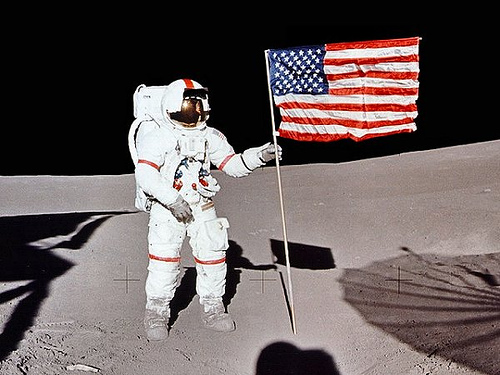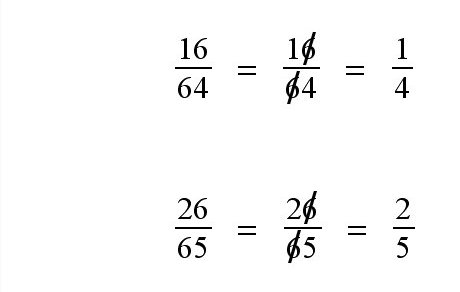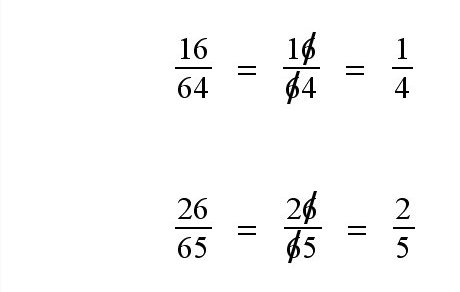(27/8)9/4 = (9/4)27/8
Science & Math
Tee Time

The last golf shots on the moon were taken by Apollo 14 astronaut Alan Shepard in February 1971.
When the crew returned to Earth, they received the following telegram from the Royal and Ancient Golf Club in Scotland:
Warmest congratulations to all of you on your great achievement and safe return. Please refer to the Rules of Golf section on etiquette, paragraph 6, quote – before leaving a bunker a player should carefully fill up all holes made by him therein, unquote.
Reductio Ad Absurdum
Forget everything you know about reducing fractions — it turns out you can just cancel individual digits:

Not convinced?


This would have made fifth grade so much easier …
(This is a ***JOKE*** -- please don't take it seriously.)
Erdös Numbers

Hungarian mathematician Paul Erdös was immensely prolific — he published about 1,500 articles in his lifetime. His influence is so great that his colleagues have taken to assigning “Erdös numbers” to one another. Erdös himself gets an Erdös number of 0; his direct collaborators get a 1; anyone who collaborates with them gets a 2, and so on.
Those in the first rank include many of the world’s top mathematicians, but there’s one standout: Hank Aaron. The Baseball Hall of Famer once signed a baseball with Erdös while accepting an honorary degree — and that, some say, counts as a joint publication.
Counting the Days
Thomas Fuller, known as the Virginia Calculator, was stolen from his native Africa at the age of fourteen and sold to a planter. When he was about seventy years old, two gentlemen, natives of Pennsylvania, viz., William Hartshorne and Samuel Coates, men of probity and respectable characters, having heard, in travelling through the neighborhood in which the slave lived, of his extraordinary powers in arithmetic, sent for him and had their curiosity sufficiently gratified by the answers which he gave to the following questions: First, upon being asked how many seconds there were in a year and a half, he answered in about two minutes, 47,304,000. Second: On being asked how many seconds a man has lived who is 70 years, 17 days and 12 hours old, he answered in a minute and a half 2,210,500,800. One of the gentlemen who employed himself with his pen in making these calculations told him he was wrong, and the sum was not so great as he had said — upon which the old man hastily replied: stop, master, you forget the leap year. On adding the amount of the seconds of the leap years the amount of the whole in both their sums agreed exactly.
— E.W. Scripture, “Arithmetical Prodigies,” American Journal of Psychology, 1891
Math Notes
(4 + 9 + 1 + 3)3 = 4913
(1 + 9 + 6 + 8 + 3)3 = 19683
Three Strikes
Predictions by Scottish mathematician and physicist Lord Kelvin, president of the Royal Society:
- “X-rays will prove to be a hoax.” (1883)
- “Heavier-than-air flying machines are impossible.” (1895)
- “Radio has no future.” (1897)
Speaking to the British Association for the Advancement of Science in 1900, he said, “There is nothing new to be discovered in physics now; all that remains is more and more precise measurement.” Einstein’s annus mirabilis came five years later.
Where’s the Fallacy?

The Ones Factory
1 × 9 + 2 = 11
12 × 9 + 3 = 111
123 × 9 + 4 = 1111
1234 × 9 + 5 = 11111
12345 × 9 + 6 = 111111
123456 × 9 + 7 = 1111111
1234567 × 9 + 8 = 11111111
12345678 × 9 + 9 = 111111111
Alcohol Problem

Fill one glass with wine and another with water. Transfer a teaspoonful of wine from the first glass into the second. Then transfer a teaspoonful of that mixture back into the first glass. Now, is there more wine in the water or water in the wine?
Most people will predict it’s the former, but in fact the two quantities will always be the same. Can you see why?
